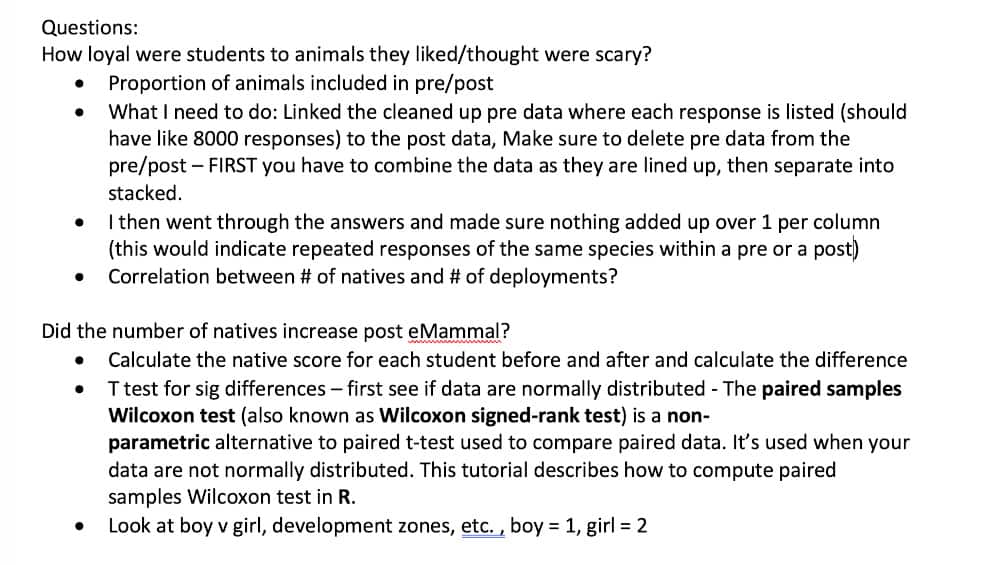
When reviewing other people’s papers or helping students, the most common mistake I see with discussions is that they do not discuss their results enough. This is not just a recap of the results section. You need to bring in other studies that have been published before and explain how your results were similar or different and what it means for science.
- No direct conservation or educational messages about specific animals, instead it’s a citizen science approach – is this enough to change perceptions?
- Data collection for use in real scientific studies (as opposed to educational programming)
- No research on this in children
3. I then copy and paste those questions into my results section. As I am doing my data analysis, I write the results in very simple, often incomplete sentences. I write them under the questions that I am answering that I just copied and pasted from the methods analysis part.
6. Now that I have the outline, I start writing sentences. DON’T WORRY ABOUT QUALITY AT ALL. Just get words on the paper. Words on the paper will give you something to work with, otherwise you will just be staring at the screen forever. Later you will go back to those words and try to make them into more well-constructed sentences.
Prepare a Cover Letter and Have Potential Reviewers in Mind

Some may take more than one paragraph, but not too many, otherwise your introduction gets long.
8. I then rewrite my results in full statements. I find the results section hard to write because it has to be objective (no interpretation of results), but you do have to write it in a way that allows people to start making sense of the results. This is hard to explain and takes practice. You don’t want to just repeat everything that can be summarized in a table, but you don’t want to interpret.
If you are a graduate student and want experience reviewing papers, you can ask your advisor if you can review one of theirs. Advisors are often sent too many to review and are looking for someone to recommend to the editor to pass their paper off to.
Other scientists! These include other professors, graduate students, or professionals in the government, nonprofits, and other places. You start getting asked to review papers once you publish a paper yourself and most people who review have graduate degrees.

In a few journals, results and discussion are separate sections. However, the trend is to merge these two sections. This section should form the bulk of your paper-by storyboarding your figures, you already have an outline!
The abstract is the elevator pitch for your article. Most abstracts are 150–300 words, which translates to approximately 10–20 sentences. Like any good pitch, it should describe the importance of the field, the challenge that your research addresses, how your research solves the challenge, and its potential future impact. It should include any key quantitative metrics. It is important to remember that abstracts are included in search engine results.
Figures are the best place to start, because they form the backbone of your paper. Unlike you, the reader hasn't been living this research for a year or more. So, the first figure should inspire them to want to learn about your discovery.
Logically, it makes sense to start a paper with the abstract, or, at least, the introduction. Don't. You often end up telling a completely different story than the one you thought you were going to tell. If you start with the introduction, by the time everything else is written, you will likely have to rewrite both sections.
5. Write the Results and Discussion Section
The methods section is one example of where knowing the journal is important. Some journals integrate the methods section in between the introduction and the results
1) To enable a reader to get more detailed information on a topic that has been previously published. For example: "The device was fabricated using a standard method." You need to reference that method. One common mistake is to reference a paper that doesn't contain the protocol, resulting in readers being sent down a virtual rabbit hole in search of the protocol.
Armani often coaches students through the process of writing their first scientific paper. Her 10-step formula for writing a scientific paper could be useful to anyone who has concluded a study and feels the dread of the blank page looming.
A classic organizational approach used by writers is "storyboarding" where all figures are laid out on boards. This can be done using software like PowerPoint, Prezi, or Keynote. One approach is to put the vision statement on the first slide, and all of your results on subsequent slides. To start, simply include all data, without concern for order or importance. Subsequent passes can evaluate consolidation of data sets (e.g., forming panel figures) and relative importance (e.g., main text vs. supplement). The figures should be arranged in a logical order to support your hypothesis statement. Notably, this order may or may not be the order in which you took the data. If you're missing data, it should become obvious at this point.

In a few journals, results and discussion are separate sections. However, the trend is to merge these two sections. This section should form the bulk of your paper-by storyboarding your figures, you already have an outline!
The abstract is the elevator pitch for your article. Most abstracts are 150–300 words, which translates to approximately 10–20 sentences. Like any good pitch, it should describe the importance of the field, the challenge that your research addresses, how your research solves the challenge, and its potential future impact. It should include any key quantitative metrics. It is important to remember that abstracts are included in search engine results.
Figures are the best place to start, because they form the backbone of your paper. Unlike you, the reader hasn't been living this research for a year or more. So, the first figure should inspire them to want to learn about your discovery.
Logically, it makes sense to start a paper with the abstract, or, at least, the introduction. Don't. You often end up telling a completely different story than the one you thought you were going to tell. If you start with the introduction, by the time everything else is written, you will likely have to rewrite both sections.
5. Write the Results and Discussion Section
The methods section is one example of where knowing the journal is important. Some journals integrate the methods section in between the introduction and the results
1) To enable a reader to get more detailed information on a topic that has been previously published. For example: "The device was fabricated using a standard method." You need to reference that method. One common mistake is to reference a paper that doesn't contain the protocol, resulting in readers being sent down a virtual rabbit hole in search of the protocol.
Armani often coaches students through the process of writing their first scientific paper. Her 10-step formula for writing a scientific paper could be useful to anyone who has concluded a study and feels the dread of the blank page looming.
A classic organizational approach used by writers is "storyboarding" where all figures are laid out on boards. This can be done using software like PowerPoint, Prezi, or Keynote. One approach is to put the vision statement on the first slide, and all of your results on subsequent slides. To start, simply include all data, without concern for order or importance. Subsequent passes can evaluate consolidation of data sets (e.g., forming panel figures) and relative importance (e.g., main text vs. supplement). The figures should be arranged in a logical order to support your hypothesis statement. Notably, this order may or may not be the order in which you took the data. If you're missing data, it should become obvious at this point.

The introduction sets the stage for your article. If it was a fictional story, the introduction would be the exposition, where the characters, setting, time period, and main conflict are introduced.
In a few journals, results and discussion are separate sections. However, the trend is to merge these two sections. This section should form the bulk of your paper-by storyboarding your figures, you already have an outline!
1) To enable a reader to get more detailed information on a topic that has been previously published. For example: "The device was fabricated using a standard method." You need to reference that method. One common mistake is to reference a paper that doesn't contain the protocol, resulting in readers being sent down a virtual rabbit hole in search of the protocol.
When conducting scientific research, Armani believes it’s important to test a hypothesis—not prove it. She recruits students who are willing to adopt that “testing” mentality, and are excited to explore the unknown. “I want them to push themselves a little bit, push the field a little bit, and not be afraid to fail,” she says. “And, know that even if they fail, they can still learn something from it.”
6. Write the Conclusion
In the conclusion, summarize everything you have already written. Emphasize the most important findings from your study and restate why they matter. State what you learned and end with the most important thing you want the reader to take away from the paper-again, your vision statement. From the conclusion, a reader should be able to understand the gist of your whole study, including your results and their significance.
Scientific papers follow a similar formula. The introduction gives a view of your research from 30,000 feet: it defines the problem in the context of a larger field
Of all the sections, the methods section is simultaneously the easiest and the most important section to write accurately. Any results in your paper should be replicable based on the methods section, so if you've developed an entirely new experimental method, write it out in excruciating detail, including setup, controls, and protocols, also manufacturers and part numbers, if appropriate. If you're building on a previous study, there's no need to repeat all of those details
2) To support statements that are not common knowledge or may be contentious. For example: "Previous work has shown that vanilla is better than chocolate." You need a reference here. Frequently, there are several papers that could be used, and it is up to you to choose.

Department of Ecology and Evolutionary Biology, University of Colorado, Boulder, UCB 334, Ramaley Hall, Boulder, Colorado, 80309 USA
Here, we present a succinct step‐by‐step guide that lays out strategies for effective scientific writing with the intention that the guide be disseminated to undergraduate students to increase the focus on the writing process in the college classroom. While we recognize that there are no hard and fast rules when it comes to scientific writing, and more experienced writers may choose to disregard our suggestions these guidelines will assist undergraduates in overcoming the initial challenges associated with writing scientific papers. This guide was inspired by Joshua Schimel's Writing Science: How to Write Papers that Get Cited and Proposals that Get Funded—an excellent book about scientific writing for graduate students and professional scientists—but designed to address undergraduate students. While the guide was written by a group of ecologists and evolutionary biologists, the strategies and suggestions presented here are applicable across the biological sciences and other scientific disciplines. Regardless of the specific course being taught, this guide can be used as a reference when writing scientific papers, independent research projects, and laboratory reports. For students looking for more in‐depth advice, additional resources are listed at the end of the guide.
Department of Ecology and Evolutionary Biology, University of Colorado, Boulder, UCB 334, Ramaley Hall, Boulder, Colorado, 80309 USA
Scientific writing, while an indispensable step of the scientific process, is often overlooked in undergraduate courses in favor of maximizing class time devoted to scientific concepts. However, the ability to effectively communicate research findings is crucial for success in the biological sciences. Graduate students are encouraged to publish early and often, and professional scientists are generally evaluated by the quantity of articles published and the number of citations those articles receive. It is therefore important that undergraduate students receive a solid foundation in scientific writing early in their academic careers. In order to increase the emphasis on effective writing in the classroom, we assembled a succinct step‐by‐Step guide to scientific writing that can be directly disseminated to undergraduates enrolled in biological science courses. The guide breaks down the scientific writing process into easily digestible pieces, providing concrete examples that students can refer to when preparing a scientific manuscript or laboratory report. By increasing undergraduate exposure to the scientific writing process, we hope to better prepare undergraduates for graduate school and productive careers in the biological sciences.
Abstract
Department of Ecology and Evolutionary Biology, University of Colorado, Boulder, UCB 334, Ramaley Hall, Boulder, Colorado, 80309 USA
While writing is a critical part of the scientific process, it is often taught secondarily to scientific concepts and becomes an afterthought to students. How many students can you recall who worked on a laboratory assignment or class project for weeks, only to throw together the written report the day before it was due?
Department of Ecology and Evolutionary Biology, University of Colorado, Boulder, UCB 334, Ramaley Hall, Boulder, Colorado, 80309 USA

Scientific papers are the medium through which scientists report their work to the world. Their professional reputation is based on how these papers are acknowledged by the scientific community.
Before we begin, let’s learn about the touchstones or benchmarks of scientific writing for authors!
When you begin with writing your scientific manuscript, the first thing to consider is the format and order of sections in relation to your research or the information you want to showcase.
Now, that you know the major standards of scientific writing, let’s dig into learning the what, why, and how of writing a scientific paper!
Ditch Your Boring, Old Editor and Write a Scientific Paper the Smart Way with Bit.ai

Accuracy – Data, figures, tables, references, and citations are illustrated verifiably and honestly.
A discussion involves talking and answering about different aspects of the scientific paper such as: what principles have been established or reinforced
The good news is, you don’t have to be a talented writer to pen-down a good scientific paper, but just have to be an organized and careful writer. This is why we have put time and effort into creating an exceptional guide on how to write a scientific paper that will help you present your research successfully to your supervisors or publications without any clutter!
Results display your findings, figures, and tables of your study. It represents the data, condensed, and digested with important trends that are extracted while researching. Since the results hold new knowledge that you are contributing to the world, it is important that your data is simply and clearly stated.
